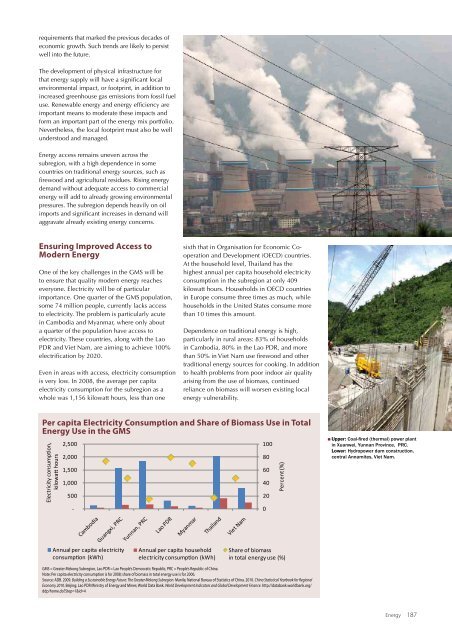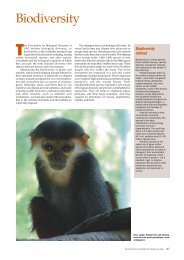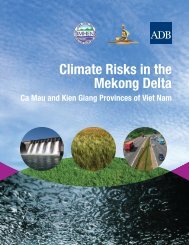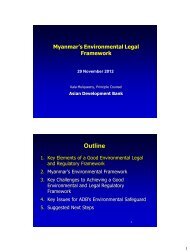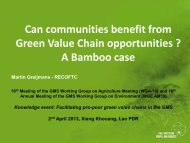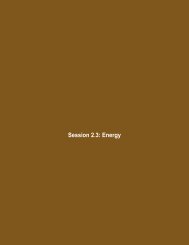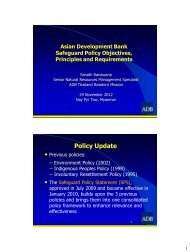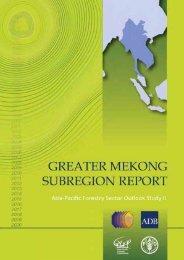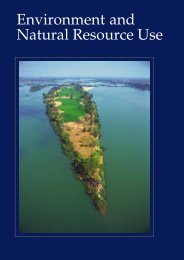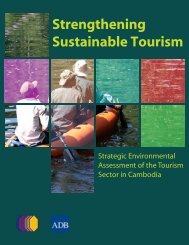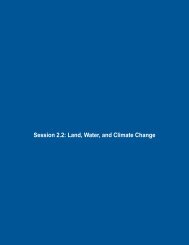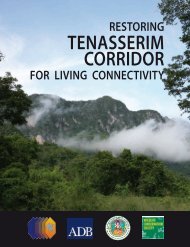Agricultural Land in the GMS (thousand hectare) in ... - GMS-EOC
Agricultural Land in the GMS (thousand hectare) in ... - GMS-EOC
Agricultural Land in the GMS (thousand hectare) in ... - GMS-EOC
You also want an ePaper? Increase the reach of your titles
YUMPU automatically turns print PDFs into web optimized ePapers that Google loves.
equirements that marked <strong>the</strong> previous decades ofeconomic growth. Such trends are likely to persistwell <strong>in</strong>to <strong>the</strong> future.The development of physical <strong>in</strong>frastructure forthat energy supply will have a significant localenvironmental impact, or footpr<strong>in</strong>t, <strong>in</strong> addition to<strong>in</strong>creased greenhouse gas emissions from fossil fueluse. Renewable energy and energy efficiency areimportant means to moderate <strong>the</strong>se impacts andform an important part of <strong>the</strong> energy mix portfolio.Never<strong>the</strong>less, <strong>the</strong> local footpr<strong>in</strong>t must also be wellunderstood and managed.Energy access rema<strong>in</strong>s uneven across <strong>the</strong>subregion, with a high dependence <strong>in</strong> somecountries on traditional energy sources, such asfirewood and agricultural residues. Ris<strong>in</strong>g energydemand without adequate access to commercialenergy will add to already grow<strong>in</strong>g environmentalpressures. The subregion depends heavily on oilimports and significant <strong>in</strong>creases <strong>in</strong> demand willaggravate already exist<strong>in</strong>g energy concerns.Ensur<strong>in</strong>g Improved Access toModern EnergyOne of <strong>the</strong> key challenges <strong>in</strong> <strong>the</strong> <strong>GMS</strong> will beto ensure that quality modern energy reacheseveryone. Electricity will be of particularimportance. One quarter of <strong>the</strong> <strong>GMS</strong> population,some 74 million people, currently lacks accessto electricity. The problem is particularly acute<strong>in</strong> Cambodia and Myanmar, where only abouta quarter of <strong>the</strong> population have access toelectricity. These countries, along with <strong>the</strong> LaoPDR and Viet Nam, are aim<strong>in</strong>g to achieve 100%electrification by 2020.Even <strong>in</strong> areas with access, electricity consumptionis very low. In 2008, <strong>the</strong> average per capitaelectricity consumption for <strong>the</strong> subregion as awhole was 1,156 kilowatt hours, less than onesixth that <strong>in</strong> Organisation for Economic Cooperationand Development (OECD) countries.At <strong>the</strong> household level, Thailand has <strong>the</strong>highest annual per capita household electricityconsumption <strong>in</strong> <strong>the</strong> subregion at only 409kilowatt hours. Households <strong>in</strong> OECD countries<strong>in</strong> Europe consume three times as much, whilehouseholds <strong>in</strong> <strong>the</strong> United States consume morethan 10 times this amount.Dependence on traditional energy is high,particularly <strong>in</strong> rural areas: 83% of households<strong>in</strong> Cambodia, 80% <strong>in</strong> <strong>the</strong> Lao PDR, and morethan 50% <strong>in</strong> Viet Nam use firewood and o<strong>the</strong>rtraditional energy sources for cook<strong>in</strong>g. In additionto health problems from poor <strong>in</strong>door air qualityaris<strong>in</strong>g from <strong>the</strong> use of biomass, cont<strong>in</strong>uedreliance on biomass will worsen exist<strong>in</strong>g localenergy vulnerability.Per capita Electricity Consumption and Share of Biomass Use <strong>in</strong> TotalEnergy Use <strong>in</strong> <strong>the</strong> <strong>GMS</strong>Electricity consumption,kilowatt hours2,5002,0001,5001,000500-100806040200Percent (%)Upper: Coal-fired (<strong>the</strong>rmal) power plant<strong>in</strong> Xuanwei, Yunnan Prov<strong>in</strong>ce, PRC.Lower: Hydropower dam construction,central Annamites, Viet Nam.Annual per capita electricityconsumption (kWh)Annual per capita householdelectricity consumption (kWh)Share of biomass<strong>in</strong> total energy use (%)<strong>GMS</strong> = Greater Mekong Subregion, Lao PDR = Lao People’s Democratic Republic, PRC = People’s Republic of Ch<strong>in</strong>a.Note: Per capita electricity consumption is for 2008; share of biomass <strong>in</strong> total energy use is for 2006.Source: ADB. 2009. Build<strong>in</strong>g a Susta<strong>in</strong>able Energy Future: The Greater Mekong Subregion. Manila; National Bureau of Statistics of Ch<strong>in</strong>a. 2010. Ch<strong>in</strong>a Statistical Yearbook for RegionalEconomy 2010. Beij<strong>in</strong>g; Lao PDR M<strong>in</strong>istry of Energy and M<strong>in</strong>es; World Data Bank. World Development Indicators and Global Development F<strong>in</strong>ance. http://databank.worldbank.org/ddp/home.do?Step=1&id=4Energy 187


